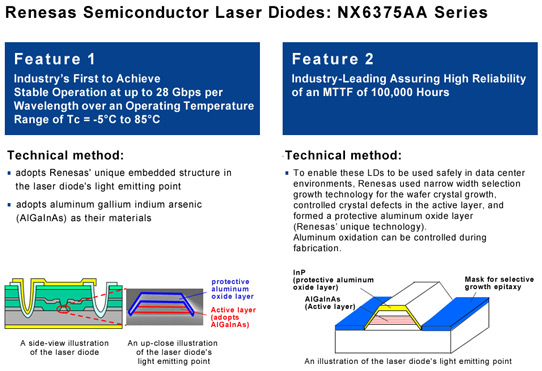- News
26 October 2016
Renesas launches first lasers achieving stable 28Gbps operation up to 85°C
Tokyo-based Renesas Electronics Corp has announced the availability of its new NX6375AA Series of direct modulation distributed feedback laser diodes (DFB LDs) supporting 25Gbps x four-wavelength operation as the light source in 100Gbps optical transceivers for communications between servers and routers installed in data centers.
The firm says that the NX6375AA Series enables the development of high-speed optical transceivers and optical modules that are highly reliable even in high-temperature environments, and the new series can be implemented in servers and routers used in data centers.
Recently, due to the popularity of cloud computing for the Internet of Things (IoT) era, the scale and processing capacity of data centers connected to the Internet and handling large amounts of data are expected to increase at 59% annual. In the optical transceivers used for communication between the servers and routers in the data centers in that environment, there is now demand for increased transmission rates, and it is expected that 100Gbps systems (which will replace the existing mainstream 40Gbps systems) will grow 75% annually.
However, there is concern that the increasing system heat generation (which is proportional to communication speed) could make the system operating state become unstable. So, the achievement of both stable operations in high-temperature environments and higher communications speeds have become a major issue for optical transceivers.
Renesas launched its first laser diodes for this application starting in 2004, when the communications data rate was 10Gbps. The new NX6375AA LD Series supports 100Gbps systems, which are expected to become the mainstream in communications systems in the future and, by resolving the issues involved, will contribute to higher speeds and increased reliability in optical transceivers, reckons the firm.
In addition, the NX6375AA Series of lasers uses Renesas' unique embedded structure and adopts aluminum gallium indium arsenic (AlGaInAs) material. Hence, by optimizing the DFB structure, the lasers are said to be the first to achieve stable operation at up to 28Gbps per wavelength over an operating temperature range of Tc = -5°C to +85°C. So, the lasers not only support 100Gbps with four wavelengths but are also capable of supporting systems operating at up to 112Gbps. Also, the four wavelengths in the laser diode series are 1271nm, 1291nm, 1311nm and 1331nm, which support coarse wavelength division multiplexing (CWDM) wavelength spacing.

To enable the lasers to be used safely in data-center environments, Renesas used narrow width selection growth technology for wafer crystal growth, controlled crystal defects in the active layer, and formed a protective aluminum oxide layer (using proprietary Renesas' technology). Since aluminum oxidation can be controlled during fabrication, the lasers achieve what is claimed to be an industry-leading mean time to failure (MTTF) of 100,000 hours.
Renesas intends to expand its range of laser diodes for 100Gbps high-speed communications. The firm is also working on expanding operation in the low-temperature range, which is required for applications such as communications base stations. Furthermore, Renesas can propose solutions with higher levels of added value by combining the lasers with the firm's high-speed optical receivers and its microcontrollers (MCUs).
Samples of the NX6375AA Series are available now, priced at $50 per wavelength. Mass production is expected to reach 100,000 units per month in April 2017 for four wavelengths.


